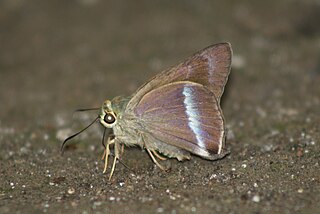
Hasora vitta, the plain banded awl, is a butterfly belonging to the family Hesperiidae which is found in India and parts of Southeast Asia.

Danielpalianosist, commonly known as the common spotted flat, is a species of butterfly belonging to the family Hesperiidae. It is a common butterfly generally found in the wet forested hills of southern Asia, from India and the Himalayas east through Indo-China. The upper surfaces of the wings are dark brown with white bands and small white spots towards the tip of the wings.
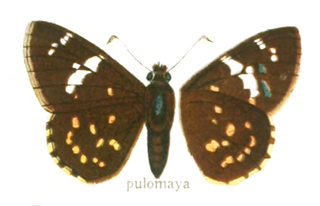
Celaenorrhinus pulomaya, commonly known as the multi-spotted flat, is a species of hesperiid butterfly found in Asia.

Poritia hewitsoni, the common gem, is a small butterfly found in India, Myanmar, Thailand, Malaysia and Vietnam that belongs to the lycaenids or blues family.

Poritia erycinoides, the blue gem, is a small butterfly found in India, Myanmar and parts of South-East Asia that belongs to the lycaenids or blues family.
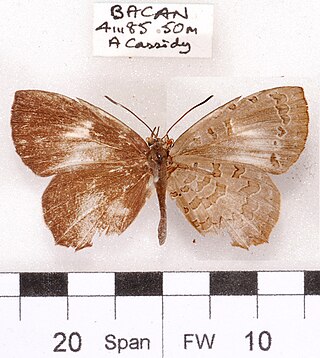
Miletus boisduvali, the common brownie, is a small but striking butterfly found in India and Myanmar that belongs to the lycaenids or blues family.
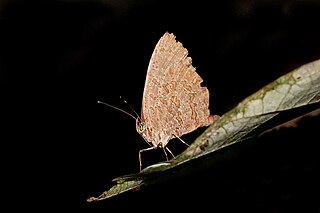
Miletus chinensis longeana, or Long's brownie, is a small but striking subspecies of butterfly found in India and Myanmar that belongs to the lycaenids or blues family.

Plebejus christophi, the small jewel blue, is a small butterfly found in Asia that belongs to the lycaenids or blues family.

Chliaria othona, the orchid tit, is a species of lycaenid or blue butterfly found in Asia.

Bibasis harisa, the orange awlet, is a species of hesperid found in Asia. The butterfly was reassigned to genus Burara by Vane-Wright and de Jong (2003) and is considered by them to be Burara harisa.

Bibasis vasutana, the green awlet, is a species of hesperid butterfly found in Asia. The butterfly was reassigned to genus Burara by Vane-Wright and de Jong (2003) and is considered by them to be Burara vasutana.
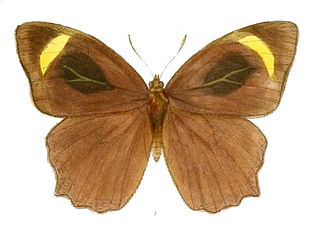
Cyllogenes suradeva, the branded evening brown, is a brown (Satyrinae) butterfly that is found in the Himalayas.
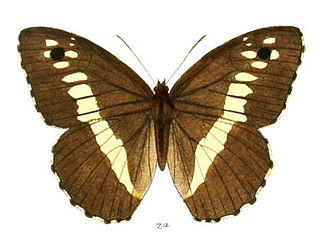
Aulocera swaha, the common satyr, is a brown (Satyrinae) butterfly that is found in the Himalayas.

Aulocera padma, the great satyr, is a brown (Satyrinae) butterfly that ranges across the Himalayas to Assam, northern Burma and western China.
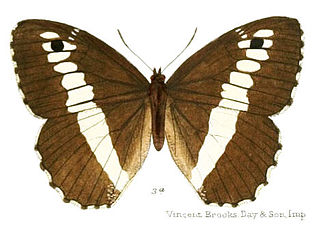
Aulocera saraswati, the striated satyr, is a brown (Satyrinae) butterfly that is found in the Himalayas.

Aulocera brahminus, the narrow-banded satyr, is a brown (Satyrinae) butterfly that is found in the Himalayas. The species was first described by Émile Blanchard in 1853.
Aulocera brahminoides is a brown (Satyrinae) butterfly that is found in the Himalayas.
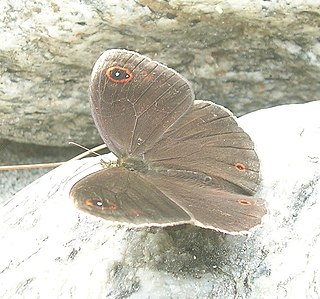
Callerebia scanda, the pallid argus, is a brown (Satyrinae) butterfly that is found in the Himalayas.

Aulocera is a genus in the subfamily Satyrinae of the brush-footed butterfly family, Nymphalidae. Commonly referred to as banded satyrs, species of the genus Aulocera are endemic to the Himalayas and associated mountain ranges.
















